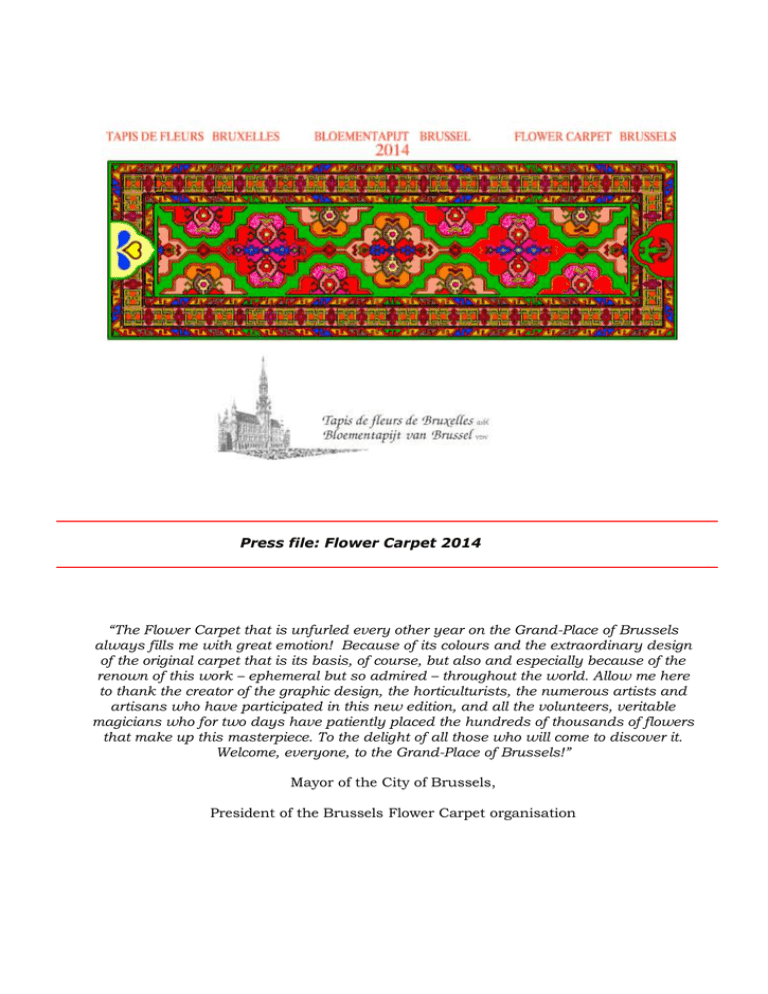click here to
advertisement

Press file: Flower Carpet 2014 “The Flower Carpet that is unfurled every other year on the Grand-Place of Brussels always fills me with great emotion! Because of its colours and the extraordinary design of the original carpet that is its basis, of course, but also and especially because of the renown of this work – ephemeral but so admired – throughout the world. Allow me here to thank the creator of the graphic design, the horticulturists, the numerous artists and artisans who have participated in this new edition, and all the volunteers, veritable magicians who for two days have patiently placed the hundreds of thousands of flowers that make up this masterpiece. To the delight of all those who will come to discover it. Welcome, everyone, to the Grand-Place of Brussels!” Mayor of the City of Brussels, President of the Brussels Flower Carpet organisation Content Press release : Flower Carpet 2014: this year, say Begonyas! .......................... 3 50 years of Turkish and Moroccan immigration .............................................. 6 Flemish begonia is unique in the world .......................................................... 7 Making a carpet ......................................................................................... 8 The opening show, musical notes ................................................................ 9 The Flower Carpet: agenda ........................................................................ 10 A brief history of the Flower Carpet ............................................................ 11 MARK SCHAUTTEET, GRAPHIC DESIGNER .................................................. 13 Press contacts and acknowledgement ......................................................... 14 c/o B.I.-T.C. Hôtel de Ville Grand-Place 1000 Bruxelles Tel. 02 548 04 50 - Fax 02 548 04 44 2 Press release : Flower Carpet 2014: this year, say Begonyas! On the occasion of this 19th edition, the Flower Carpet of the Grand Place has chosen to celebrate the 50th anniversary of Turkish immigration in Belgium. 1,800 m2 of begonias (begonyas in Turkish) will make up an ephemeral tapestry inspired by the geometric patterns of Turkey's famous kilims. Visitors will have the opportunity to admire this astonishing display from 14 to 17 August 2014, to sense all its tones and all its nuances, whether from the Grand-place itself or from above, from the balcony of the City Hall. A magical masterpiece, colourful and scented, what better way to pay tribute to the Turkish community of Brussels! Turkish immigration in Belgium On 16 July 1964, Belgium and Turkey signed the bilateral convention which led to Turkish immigration in Belgium. 50 years ago the first Turkish workers arrived here. Bridges and social interactions were built between the communities, and the two cultures got to know each other. Nowadays, over 220,000 Turkish-born individuals are residing in Belgium and migration from Turkey continues. The year 2014 is an opportunity to highlight the memory of Turkish immigration in Belgium, and especially in Brussels, to promote cultural creations of Turkish origin, and to strengthen the sense of belonging to Belgian citizenship. Which is why, this year, the Flower Carpet selection committee has chosen this theme, which is so important to our multicultural Region. The Turkish carpets or kilims Moreover, carpets are an integral part of Turkish culture. They are popular objects which are handed down from generation to generation. They are both useful items and decorative objects. Tradition dictates that a carpet should bear the name of the town where it was made. During Ottoman times, carpets were a status symbol and were presented as gifts to kings and sultans. Patterns on Turkish carpets are incredibly varied and geometrical (diamonds, rectangles, stars, squares) and also include floral or animal patterns. The patterns represent and symbolise myths and beliefs: fertility, joy, happiness or protection from the evil eye. For instance, images of the hook, the eye or the scorpion protect, while birds are a symbol of life. Turkey is well-known for its carpets, produced in every region: from Uşak (Ouchak), patterns used for the Brussels flower carpet, Hereke, a small town near Istanbul which, for centuries, created splendid carpets for the Ottoman palace, and many more, such as Sivas, Manisa, Ladik and many more. In the past, the carpets and kilims of Eastern Anatolia were for the most part made by nomadic or semi-nomadic populations. The border city of Kars is an important region for the carpet trade. In no other city do so many different populations cohabitate. Tatars, Armenians, Cherkessians, Azerbaidjanis, Kurds and Turkmens have lived there in harmony for centuries. Twenty years ago, the well-known Kars-Kasaks were made there, c/o B.I.-T.C. Hôtel de Ville Grand-Place 1000 Bruxelles Tel. 02 548 04 50 - Fax 02 548 04 44 3 carpets which are much enjoyed here, in dark tones of brown and green. In the past, Erzurum was an important stop on the Silk Road, between Persia and the Black Sea. Kilims formerly weaved in this region are exceptionally beautiful and sought after by collectors. Sivas carpets boast an exceptional quality of wool and meticulous knotting. Carpets and kilims from the district of Malatya are, for the most part, homemade by semi-nomads or nomadic settlers. Production of woven items is much greater than that of knotted carpets. Thanks to the number of gifts conserved in mosques, it has been possible to identify the carpets with great precision. The most beautiful Kurdish works, both woven and knotted, come from this region. Many nomads spend their winter in the fertile plains of the Euphrates. The striped kilims are particularly beautiful. One of their qualities is that, for those made up of two bands which are sewn together, each one is a complete composition in itself, unlike other Anatolian kilims in which the two halves almost always combine into a single composition. Many symbols can be found on these carpets, such as hourglasses, crosses, S-patterns, diamond shapes with hook tips and octagons. Anatolian carpets are the most expensive on the global market but demand remains just as great. Flowers in Turkey Turkey's flora is one of the richest around the Mediterranean! Did you know that tulips, which are generally associated with Holland, actually originated in Turkey. In fact, the name stems from the Turkish 'tülben', also the root of the English word 'turban'. Tulips were discovered in the 16th century. In 1554, learned Flemish botanist and Austrian ambassador, Augier Ghislain de Busbecq, decided to send to Vienna some tulip seeds which he had discovered in Turkey some years earlier. In 1593, a friend of Augier Ghislain de Busbecq introduced the flower to Holland by selling his personal collection of tulips. While it was used as a decorative element of Turkish art for many centuries, the tulip then gave its name to an era, "the Tulip Age", which corresponds to the period from 1703 to 1717. Suleiman the Magnificent was fascinated with this flower and held many celebrations in its honour. As it is from Persia, the flower features widely in the Tales of the Arabian Nights, where its red colour symbolises eternal love. But the Flower Carpet is made up of begonias, begonyas in Turkish! A few figures The flower carpet is 75 m long and 25 m wide. 1,800 m2 of begonias! It takes 2 years to bring about: the million cut flowers used for the composition need to be reserved well in advance. A gamble which is both beautiful and very daring. The weather, the number of visitors, the tour within the city hall, timing... all these details are significant. The flowers are kept fresh and radiant for four long days. How do we achieve this? Just before the opening, 120 volunteers bring colour to the carpet, based on a life-sized image which is laid down on the paving stones of the Grand-Place. c/o B.I.-T.C. Hôtel de Ville Grand-Place 1000 Bruxelles Tel. 02 548 04 50 - Fax 02 548 04 44 4 The image is drawn on micro-perforated plastic which is fixed to the ground on top of a fine layer of sand. The first Grand-Place flower carpet dates back to 1971. The 2014 masterpiece is the 19th flower carpet to be designed for your delight. The flowers seen from the sky (or nearly!) It is already a tremendous pleasure to stroll around the Grand-Place, a gem of Gothic architecture, discovering the 2014 flower carpet, breathing in the scents and experiencing all its nuances! But then what about a visit to the balcony of the City Hall? A wide-angle view which the privileged visitors will hold in memory for years to come! As well as the colours and scents, a sound and light show The opening evening will take place on 14 August. A musical theme has been especially composed for this summer display. The programme holds an array of unexpected colours and sounds! The Grand-Place will be metamorphosed for the event. The concert will be held again every evening to accompany a splendid sound and light show! Practical information The Flower Carpet will light up the Grand-Place in Brussels on 15, 16 and 17 August 2014. The opening will take place on 14 August from ... to ... Not to be missed, to admire the carpet as a whole, from above: a panoramic view from the balcony of the City Hall: tours are held from 9 a.m. to 11 p.m. Every evening, at 10, 10.30 and 11 p.m., a splendid sound and light show especially created for the occasion of the 2014 Flower Carpet. Entry price €5. Free entry for children under the age of 10. www.flowercarpet.be c/o B.I.-T.C. Hôtel de Ville Grand-Place 1000 Bruxelles Tel. 02 548 04 50 - Fax 02 548 04 44 5 50 YEARS of Turkish and Moroccan immigration On 17 February 1964, Belgium finalised a bilateral agreement with Morocco, allowing for Moroccan workers to be recruited for the needs of the Belgian economy. A few months later, Turkey signed a similar document on 16 July 1964. Conferences, thematic meetings, theatre performances, concerts, film evenings and round table meetings will mark the 50th anniversary of these agreements, spread out over several months. The purpose is for new generations to revisit the history of Turkish and Moroccan immigration in Belgium but also to highlight social cohesion and the sense of Belgian citizenship. History From 1820 to 1950, nearly 70 million Europeans emigrated to do business or to escape war and misery. Since then, the tables of history have turned, and Europe has welcomed millions of immigrants. In the 40s, they first came from Europe (Spain, Italy, Greece, Portugal) followed, in the 60s, by Moroccans and Turks responding to the calls of Belgian entrepreneurs (mining and metals industries, construction and textile sectors,...). A better life with paid work first enticed the men, who came alone, hoping to head home before too long. The crisis of the 70s led to borders being closed but also to the first family reunification policies. Immigration progressively became more female-oriented and younger, settled more sustainably and became more visible in the public space. Mosaic Belgium Immigration is a global fact and has shown over time that it is not something which takes place occur in just one direction. It comprises a challenge and multiple advantages for the host country. It requires integration policies and it asks of the immigrants themselves to live in tune with their new host society. Belgium has really become a mosaic of societies, culture and identity, a truly multicultural society in a state of constant renewal, integrating migration flows to redefine its history and reshape democratic representations within its population. Source: "Penser l’immigration et l’intégration autrement [Seeing immigration and integration differently]", a Belgian inter-university initiative, Bichara Khader, Marco Martiniello, Andrea Rea, Christiane Timmerman, Bruylant publishers 2006. c/o B.I.-T.C. Hôtel de Ville Grand-Place 1000 Bruxelles Tel. 02 548 04 50 - Fax 02 548 04 44 6 Flemish begonia is unique in the world With its long flowering period, broad range of colours, variety of shapes and suitability for borders and patios alike, the Flemish begonia has many strengths, which are the result of years of tradition and craftsmanship. No wonder that the Flemish begonia is a success as far away as Japan and America. Tradition and craftsmanship Flanders is the world’s leading producer of tuberous begonias, thanks to a rich tradition of seed selection and tuber production. Every year, over 30 million tubers are exported to Europe, North America and Japan. Begonia cultivation is chiefly concentrated in East Flanders, and more specifically in the region around Ghent. Selection companies are continuously looking for new colours and flower shapes. The most popular types are the double begonias and the hanging varieties. The immense Belgian flower carpets of tuberous begonias present an alluring picture and enjoy international renown. The begonias are perfectly showcased in all their colourful splendour. Flower spectacle for the garden and the patio Tuberous begonias are the perfect choice for anyone who loves striking colours. Colours range from white to yellow, and orange to red, as well as a whole spectrum of pinks; and flowers can be either single, hanging or double. The begonia range offers a wide selection, meaning that there will always be a begonia to suit every taste, and to complement the rest of your plant arrangement. With its abundant and long-lasting flowering period, it will provide colour from early July right up to the first frost. Furthermore, tuberous begonias are extremely versatile, as they can be used for balconies, in hanging baskets, on patios, or as bedding plants. They require little maintenance and also have the benefit of being allergy friendly, as they do not cause hay fever. c/o B.I.-T.C. Hôtel de Ville Grand-Place 1000 Bruxelles Tel. 02 548 04 50 - Fax 02 548 04 44 7 Making a carpet The actual making of the carpet is based on a plan worked out in advance, consisting of several stages. Everything starts, often a year in advance, with projects and scale models, illustrating a commissioned theme. Once the theme has been produced in representation and symbol, the number of flowers and color combinations calculated and the outlines finally drawn on the ground, then the work starts. The skilful, dedicated work of a hundred experienced gardeners and their enthusiasm enables them to put together this giant floral jigsaw in under four hours. The day before, the spaces between the floral patterns will already have been filled with rolled turf. Did you know that the flowers are packed together one by one, 300 to every square meter of the ground (+/- 800.000 flowers!), so tightly (no soil is used at all) that they won't be blown away by the first puff of wind, and create their own microclimate? In heat waves, the turf has to be watered to prevent it from shrinking, but if the weather is too wet, the grass can grow 4 to 5 centimeters in 3 days? The wonders of nature! Ephemeral beauty Always the same, yet different each time, no carpet is like any other, even if it is always essentially made up of 800,000 begonias ("tuberosa grandiflora"), one of the glories of Belgian horticulture. The Begonia The beauty and diversity of all these carpets is largely due to their main component, the famous begonia. Chosen above all for its qualities of robustness, resistance to bad weather and strong sunshine the begonia guarantees the long life and freshness of the carpet. It also gives it is rich range of colors - from vivid colors to delicate pastel shades, with in between, the parti-colored and white flowers which reflect the light so well. This flower, the ideal ornament, which is already traditionally used in pageants and floral corsages, is also much loved by householders who use them to brighten their balconies and windowsills and embellish their flowerbeds. 80 % of the total production of begonias, a native of the West Indies, cultivated almost exclusively in the Ghent area since 1860, is exported. Belgium cultivates 60 million begonia tubers every year, and is recognized as the world's largest producer. The Netherlands, France and the United States are its best customers. Other natural elements will be called upon to render the more particular colours of this glimmering flower carpet. Dahlias will take the place of blue entrelacs. The green will be grass, and tree bark will render the brown nuances that form the background of the carpet. c/o B.I.-T.C. Hôtel de Ville Grand-Place 1000 Bruxelles Tel. 02 548 04 50 - Fax 02 548 04 44 8 The opening show, musical notes For the opening of the Brussels' Flower Carpet 2014. The music will reveal a melting pot of sounds, scents, emotions and impressions. Like the soundtrack of a film, it will tell the story of the epic and imaginary journey of a group of nomads through the plains of Anatolia. Following the rhythm of the seasons, the atmosphere will evolve from a peaceful, nearly sleepy beginning to an anthology of spring time scents, finishing with a rythmic explosion heralding a storm on a summer's night. The music will blend contemporary sounds to traditional instruments like the Saz (type of long-necked lute), the Daf (sacred drum) and the Violin. The musician-composer Grégoire Dune, responsible for the opening show’s music, studied violin, chamber music and composition at the Royal Music Conservatory of Brussels, where he received his first awards and his higher level diploma. The irrepressible artist, unparalleled multi-instrumantalist (violin, guitar, keyboards), has been on many tours around Europe, the United States and Quebec. He has produced, composed, arranged, performed and collaborated on recording a hundred or so classical, pop and film music albums (various sessions for Alain Souchon, Alain Chamfort, Niagara, Michel Legrand, Aereda, Arthur H, etc.). c/o B.I.-T.C. Hôtel de Ville Grand-Place 1000 Bruxelles Tel. 02 548 04 50 - Fax 02 548 04 44 9 The Flower Carpet: agenda August 14 2014: day for the press – day of construction From 9 am Possibility to interview the organizers (on appointment) 1 pm The first flowers are set by around 100 people 2 pm “Press” opening at the City Hall and possibility to watch the Flower Carpet during the realisation. Possibility to interview the workers. Official inauguration at the “Maison du Roi” and the City Hall (entrance only by showing the invitation paper). 8:30 pm 10 pm 11 pm Fireworks and concert Closure August 15, 16, 17, 18 and 19 2014: opening for the public Every night at 10, 10.30 and 11 pm : sound and light From 9 am till 11 pm (except for Sunday 19, till 6 pm): Opening of Town Hall: the balcony is opened for the visitors, panoramic view : €5, children younger than 10 enter for free More information on: www.flowercarpet.be c/o B.I.-T.C. Hôtel de Ville Grand-Place 1000 Bruxelles Tel. 02 548 04 50 - Fax 02 548 04 44 10 A brief history of the Flower Carpet Officially, the first Flower Carpet as its present-day form was created in 1971 on the Grand-Place by the landscape architect E. Stautemas, but, in fact, it was the culmination of a whole series created in various towns in Flanders. E. Stautemas, who was born in Zottegem, and graduated from the Ghent Horticultural College, had been experimenting since the early 50's making simple small carpets, more like rugs, mainly consisting of begonias (in Knokke, Oudenaarde, Sint-Niklaas, Lille…). He very quickly realised that floral carpets would be an excellent vehicle for the promotion of his beloved begonias which he had always worked with, both technically, economically and aesthetically. After years of attempts and calculations, this architect, who was inventive and imaginative, and knew how to make the most of the numerous resources of begonias, became an expert in the creation of superb floral carpets with sophisticated colors and complicated designs. His fame spread and he was asked to make carpets not only in Belgium (Ghent, Bruges, Antwerp, Ypres, Courtrai, Hasselt, Tongres, Mons, Durbuy…) but worldwide (Cologne, Hamburg, Luxemburg, Paris, London, Breda, Amsterdam, The Hague, Vienna, Valencia, and as far afield as Buenos Aires and Colombus, Ohio). Since his disappearance, the landscape architect Mark Schautteet has taken over with talent. The carpets of Brussels’ lace and the Gardens of Versailles have enchanted thousands of visitors since the year 2000. Some of these carpets were bigger than the ones created in Brussels (77 x 24 m), like the 1973 masterpiece at Sint-Pietersplein, Ghent that reached a gigantic 164 x 42 m. However, as E. Stautemas himself says: "Nowhere is the carpet more beautiful and distinguished than in the unique, ancient surroundings of the Grand-Place in Brussels." Themes of the carpets 1971: 1st Flower Carpet in Brussels: a garden 1976: Year of the Landscapes, Parks and Gardens 1979: Brussels Millenium 1980: Celebration of Belgium's 150 anniversary 1986: Coat of Arms of the City of Brussels 1988: A Chinese Carpet, inspired by the carpets of the Chinese province of Sinkiang 1990: Year of Mozart 1992: Brussels, Capital of Europe 1994: 50th anniversary of the Liberation of Brussels 1996: A garden "à la française" 1998: A carpet inspired by the semi-nomadic tribes living today in NE of Turkey 2000: Brussels' lace 2002: Versailles 2004: Art Nouveau 2006: Middle Ages c/o B.I.-T.C. Hôtel de Ville Grand-Place 1000 Bruxelles Tel. 02 548 04 50 - Fax 02 548 04 44 11 2008: 2010: 2012: 2014: Savonnerie Europe The African continent The Turkish and Moroccan immigration c/o B.I.-T.C. Hôtel de Ville Grand-Place 1000 Bruxelles Tel. 02 548 04 50 - Fax 02 548 04 44 12 MARK SCHAUTTEET, GRAPHIC DESIGNER In the 1970s, he started working for Et. Stautemas (pioneer of the begonia carpet) producing various begonia carpets. Together they created begonia carpets in Brussels, Columbus-Ohio, Vienna and The Hague. These carpets confirmed their major international appeal. When Et. Stautemas passed away in 1998, Mark decided to carry on his mentor’s pioneering work and further it through promoting the begonia as an export product, using the flower carpets, in association with the begonia committee. Between our borders many market squares have already been transformed with a stunning colourful begonia carpet designed by Mark Schautteet. Achievements abroad in recent years should also not be overlooked: In Belgium: Brussels Tongeren Seneffe Koksijde Leuven Oudenaarde Zaventem Zottegem Genk c/o B.I.-T.C. International: Frankfurt Shanghai Haarlem New Delhi Warsaw Tel Aviv Tenerife Prague Barcelona Bern Hôtel de Ville Grand-Place 1000 Bruxelles Tel. 02 548 04 50 - Fax 02 548 04 44 13 Press contacts Annette Katz Tel. +32-(0)2-513.89.40 E-mail : a.katz@visitbrussels.be Karel Goethals Tel. +32-(0)2-340.92.41 E-mail: karel@voice.be Visual material available on request More information on the website: www.flowercarpet.be Acknowledgement NPO Flower Carpet returns thanks to : - la Ville de Bruxelles et ses services la Région de Bruxelles-Capitale l’Ambassade de Turquie en Belgique les Floralies gantoises la Loterie Nationale la chocolaterie Léonidas l’Hôtel Amigo la STIB la SNCB Interparking JC Decaux le VLAM la RTBF – La Première et Viva Bruxelles L’Avenir Radio 2 l’A.V.B.S. CBC KBC Fintro Sofitel-brussels-le-louise.com Sofitel-brussels-europe.com Hotel Plaza Hôtel Léopold and all partners who contribute to the succeeding of the event. c/o B.I.-T.C. Hôtel de Ville Grand-Place 1000 Bruxelles Tel. 02 548 04 50 - Fax 02 548 04 44 14






